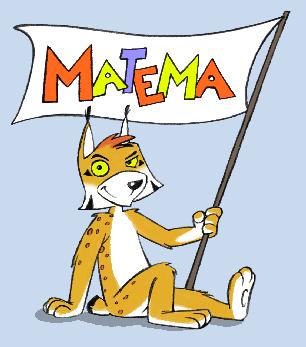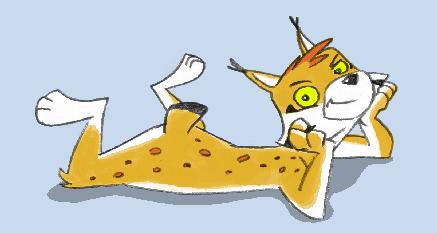Matthias Ehrhardt
Wie modelliert man Mobbing in der Schule?
Mathematische Modellierung in der Gesellschaft
|
 |
Materialien für Interessierte zum Vortrag am
Die Zielgruppe sind Schüler ab der 11. Klasse.
|
 |
|

Das MATEMA-Logo (ein Luchs, copyright by Ulf Grenzer)
Beschreibung
Mobbing in Schulen ist definiert als eine Form von wiederholten aggressiven Verhalten
basierend auf einem Machtungleichgewicht von Macht
Mobbing ist ein gruppendynamischer sozialer Prozess, bei dem die
Angriffe meist unprovoziert sind. Diese Angriffe können physisch oder verbal, direkt oder indirekt sein.
Hier konzentrieren wir uns auf eine einfache mathematische Modellierung der Ausbreitung von Mobbing
in der Schulbevölkerung und wollen anhand des Modells Gegenmaßnahmen diskutieren.
Als Daten stehen uns eine OECD und eine PISA Studie aus dem Jahre 2015 zur Verfügung.

Das MATEMA-Logo (ein Luchs, copyright by Ulf Grenzer)
Referenzen für den Vortrag
- A.C. Baldry, D.P. Farrington,
Bullies and delinquents: personal characteristics and parental styles,
J. Community Appl. Soc. Psychol. 31(1) (2000), 17-31.
- K. Bjorqvist, K.M.J. Ekman, K. Lagerpetz,
Bullies and victims: their ego picture, ideal ego picture and normative ego picture,
Scand. J. Psychol. 23(1) (1982), 307-313.
- E. De la Poza, L. Jódar, L. Ramírez,
Modelling bullying propagation in Spain: a quantitative and qualitative approach,
Qual. Quant. (2017).
- A. Durban, F. Dahlmanns, U. Käser,
Die Rolle von Freundschaften im Kontext von Bullying,
Bildung und Erziehung 71 (2018), Bullying/Cyberbullying, 11-26.
- I. Garcia, L. Jódar, P. Merello, F.-J. Santonja,
A discrete mathematical model for addictive buying: predicting the affected population evolution,
Math. Comput. Model. 54(7-8) (2011), 1634-1637.
- L.B. Huddleston, K. Varjas, J. Meyers, C. Cadenhead,
A case study with an identified bully: policy and practice implications,
West. J. Emerg. Med. 12(3), (2011), 316-323
- U. Käser, U.M. Röhr-Sendlmeier,
Zum Umgang mit realer und virtueller Gewalt in der Schule,
Bildung und Erziehung 71 (2018), Bullying/Cyberbullying, 4-10.
- A.M. Kohm,
Bullying and social dilemmas: The role of social context in anti-social behaviour,
2011.
- K.M.J. Lagerspetz, K. Bjorkqvist, M. Berst, E. King,
Group aggression among school-children in 3 schools,
Scand. J. Psychol. 23(1) (1982), 45-52.
- A. Mazzone, M. Camodeca, C. Salmivalli,
Interactive effects of guilt and moral disengagement on bullying, defending and outsider behavior,
J. Moral Educ. 45(4) (2016), 419-432.
- T. Mooij,
Differences in pupil characteristics and motives in being a victim, perpetrator and witness of
violence in secondary education,
Res. Pap. Educ. 26(1) (2011), 105-128.
- C. Morcillo, et al.,
Socio-cultural context and bulling others in childhood,
J. Child Fam. Stud. 24(8) (2014), 2241-2249.
- OECD,
Skills for Social Progress -
The Power of Social and Emotional Skills,
OECD Skills Studies, 2015.
- A.D. Pellegrini, M. Bartini, F. Brooks,
School bullies, victims, and aggressive victims: factors relating to
group affiliation and victimization in early adolescence,
J. Educ. Psychol. 91(2) (1999), 216-224.
- PISA 2015 Results (Volume III) Chapter
Bullying, 2015.
- R.M. Raafat, N. Chater, C. Frith,
Herding in Humans,
Trends Cognit. Sci. 13(10) (2009), 420-428.
- S. Saarento, C. Salmivalli,
The role of classroom peer ecology and bystanders' responses in bullying,
Child. Dev. Perspect. 9(4) (2015), 201-205.
- M. Sainio, R. Veenstra, G. Huitsing, C. Salmivalli,
Victims and their defenders: a dyadic approach,
Int. J. Behav. Dev. 35(2) (2011), 144-151.
- C. Salmivalli, et al.,
Bullying as a group process: participant roles and their relations to social status within the group,
Aggress. Behav. 22 (1996), 1-15
- C. Salmivalli, K. Peets,
Bullies, victims, and bully-victim relationships in middle childhood and adolescence,
In: B. Laursen, K. Rubin, W.M. Bukowski (eds.),
Handbook of Peer Interactions, Relationships, and Groups,
Guilford Press, New York (2009)
- P.K. Smith, et al.,
The Nature of School Bullying. A Cross National Perspective,
Routledge, London (1999)
Spanish Statistics Institute. www.ine.es (2015)
- E. Sticker, L. Bieler,
Konstellationen von Mobbing in der Schule - Darstellung von Problemlagen und
Formen der Unterstützung in einem Lehrerforum,
Bildung und Erziehung 71 (2018), Bullying/Cyberbullying, 27-48.
- J.D. Unnever,
Bullies, aggressive victims, and victims: are they distinct groups?,
Aggress. Behav. 31(2) (2005), 153-171.
- A.J.A.M. Van Deursen, C.L. Bolle, S.M. Hegner, P.A.M. Kommers,
Modeling habitual and addictive smartphone behavior:
the role of smartphone usage types, emotional intelligence, social stress,
self-regulation, age, and gender,
Comput. Hum. Behav. 45 (2015), 411-420.





